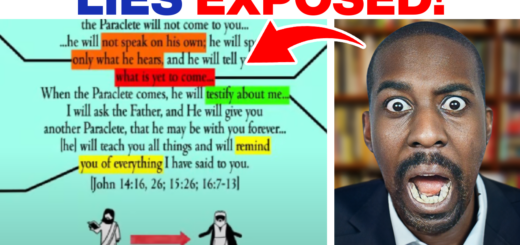Destroying Hebrew Israelites Best Verse On Jesus Being Black!
Among the many doctrines promoted by Hebrew Israelite groups, one of the most commonly repeated is the claim that Jesus was Black — and that the Bible proves it. Their go-to passage? Revelation 1:14–15.
You’ll often hear this passage quoted on street corners, social media, and in open-air gatherings. But does this text really prove Jesus’ skin color? Does it describe His race, or is something else going on?
In this article, we’ll walk through their argument, examine the text, and unpack what the Bible actually says — and doesn’t say — about Jesus’ physical appearance.
 The Claim: Revelation Describes Jesus as a Black Man
The Claim: Revelation Describes Jesus as a Black Man
At a public outreach in Kenya, a prominent leader of a Hebrew Israelite movement declared:
“Jesus Christ is a Black man according to the Holy Scriptures…”
He went on to quote the passage:
“His head and his hairs were white like wool, as white as snow; and his eyes were as a flame of fire; And his feet like unto fine brass, as if they burned in a furnace…” – Revelation 1:14–15
 From this, they argue:
From this, they argue:
- “Hair like wool” refers to Afro-textured hair.
- “Feet like burnt brass” means Jesus had dark skin.
- “Eyes like a flame of fire” are explained by Genesis 49:12, which says, “His eyes shall be red with wine.”
They interpret this as a prophetic connection showing that Jesus had bloodshot or fiery eyes because He drank wine — further supporting their racialized imagery.
However, while Genesis 49:12 is indeed a messianic prophecy, the “eyes red with wine” phrase is poetic and symbolic, typical of prophetic literature, not a literal physical trait.
It describes the richness, joy, and abundance associated with the coming Messiah — not His eye color.
Let’s slow down and take a closer look at Revelation 1:14:
“His head and his hairs were white like wool, as white as snow…”
Two important things stand out here:
- The verse says His head and His hairs were white. This isn’t just about hair texture — it’s about color. “White like wool” is further explained as “white as snow,” emphasizing brightness, not ethnicity.
- The focus is not on racial features, but on divine imagery. White hair is symbolic of age, wisdom, and purity — common themes used to describe God Himself in Scripture:
“The Ancient of Days did sit… the hair of His head like the pure wool…” – Daniel 7:9
This verse in Daniel refers to God the Father and uses similar symbolic language. Revelation borrows from this imagery to describe Jesus in His glorified state, not His earthly appearance.
 A Misuse of Symbolism
A Misuse of Symbolism
Interpreting apocalyptic literature like Revelation requires care. It is filled with symbolism, visions, and metaphors, not photographic realism.
Take these examples from the same passage:
“Out of his mouth went a sharp two-edged sword…” – Revelation 1:16
“His countenance was as the sun shineth in his strength.” – Revelation 1:16
Should we assume Jesus literally has a sword sticking out of His mouth? Or that His face literally looks like the sun? No. These are powerful symbols representing spiritual truths.
- The sword represents His word and authority (Hebrews 4:12).
- The shining face reflects His divine glory (Matthew 17:2; Exodus 34:29).
When we apply the same lens to His hair and feet, we understand that John is describing the majesty and glory of Christ — not His ethnicity.
Now, let’s address the second claim: that Jesus’ “feet like burnt brass” means He had Black skin.
Here’s the full verse:
“And his feet like unto fine brass, as if they burned in a furnace…” – Revelation 1:15
Once again, the emphasis is on appearance — not race. Burnished or refined brass, when heated in a furnace, glows. It becomes luminous, bright, radiant — not simply dark or blackened.
The passage highlights Jesus’ radiance and purity, echoing the imagery found in Ezekiel 1:7:
“And their feet sparkled like the color of burnished brass…” – Ezekiel 1:7
This description doesn’t denote ethnicity. It points to divine brilliance and majesty.
 Understanding the Symbolism of White Hair and a Shining Face
Understanding the Symbolism of White Hair and a Shining Face
Further context comes in Revelation 1:16:
“And his countenance was as the sun shineth in his strength.”
The word “countenance” (Greek:opsis) refers to His face.
John says Jesus’ face shone like the sun, at its brightest — intense, blinding light. That aligns with His head and hair being described as white like snow.
In fact, this helps explain the broader scene: John is seeing Jesus in His post-resurrection, glorified state. What he sees is not a racial identifier, but a vision of divine power and holiness.
We must remember, John wasn’t describing what Jesus looked like as a carpenter in Nazareth — he was seeing the glorified Christ in heaven.
 A Better Way to Understand Jesus’ Identity
A Better Way to Understand Jesus’ Identity
To be clear: There’s no Biblical reason to believe Jesus was white, European, or blond-haired.
He was born in first-century Judea, in the Middle East. Ethnically, He would have had features typical of Jewish men from that region — olive-toned skin, dark hair, and Semitic features.
But here’s the key truth: the Bible doesn’t focus on Jesus’ skin color.
Instead, the Gospel centers on who Jesus is — the Son of God, the Lamb of God, the Savior of the world.
Scripture makes no attempt to describe His physical appearance in earthly terms, because that’s simply not what matters most.
When we try to build doctrines on misread symbolism or make ethnicity the cornerstone of theology, we risk missing the heart of the gospel entirely. Share on X
 The Glory of Christ, Not the Color of His Skin
The Glory of Christ, Not the Color of His Skin
Revelation 1:14–15 is a stunning passage — not because it reveals Jesus’ race, but because it powerfully displays His glory, wisdom, and divine power.
Yet despite this, Hebrew Israelites often appeal to this passage to support their racial claims.
However, a fair and contextual reading clearly shows that these verses were never intended to describe Jesus’ skin color. Rather, they portray Him as the exalted, eternal King — majestic, radiant, and awe-inspiring.
Therefore, instead of reshaping Jesus into our cultural image, we should allow Scripture to shape our understanding of who He truly is.
If you’d like to see another example of how misreadings can lead to confusion — and how context brings clarity — be sure to check out this related article. Explore a passage from Luke 22 that some use to challenge Jesus’ authority — and discover why the truth lies in the details.
WATCH THE VIDEO
























Recent Comments